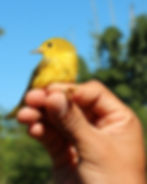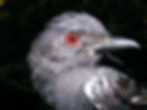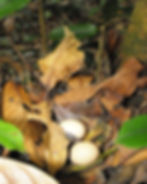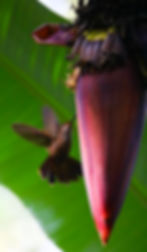
Bird Research Team
Understanding the diversity, distribution, population dynamics and
optimal conservation strategies of forest-dwelling birds in Amazonian Peru
Our tropical ornithology research in Peru, featuring our Head Field Research Coordinator, Chris Ketola. Video credit: Foggy Lens Productions
Bird Team Objectives
Our Bird Team, which is headquartered in the cities of Puerto Maldonado and Cusco, is tasked with the following principle scientific and conservation objectives: (i) to establish baseline datasets of the diversity and abundance of over 600 species of birds at Amazonian field sites in the Madre de Dios and Cusco regions of Peru; (ii) to monitor changes in the diversity, abundance and community structure of birds at these sites over time scales ranging from months to years and even decades; (iii) to compare and contrast sites in terms of bird diversity, abundance and community structure; (iv) to understand and explain the differences and changes in bird communities within and between sites and over time (seasons, years, decades) with respect to environmental and anthropogenic variables such as climate (temperature, rainfall), forest type (terra-firme, floodplain), land-use categories (protected areas, indigenous or native community forest, ecotourism concessions, timber and non-timber extractive reserves, bushmeat hunting areas, and forests surrounded by or immediately adjacent to agricultural and cattle ranching areas), and underlying human-related disturbance as measured by distance from towns and villages, roads, and large navigable rivers; (v) to identify bird populations or communities that are changing particularly rapidly and the likely underlying causes of this change; (vi) to provide forest land owners and managers with information about the conservation status of the bird community in their forest; (vii) to educate the general public in Peru and worldwide about Neotropical birds; and ultimately (viii) to promote conservation actions at the species, site and landscape level that will help conserve the avifauna of Peru.
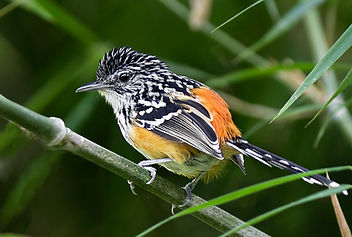.jpg)
Striated antbird (Drymophila devillei)
Photo: Tom Ambrose

A male Band-tailed manakin (Pipra fasciicauda) having its wing evaluated for moult limits and general
wear and tear. Photo: Fauna Forever
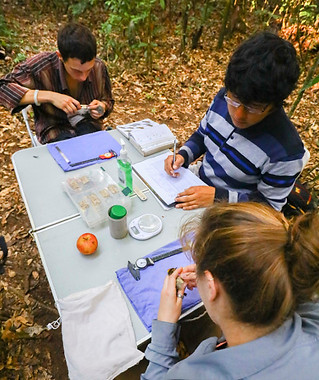
A typical banding station in the forest, with one research coordinator and a couple of interns. Photo: Ian Paul Markham.
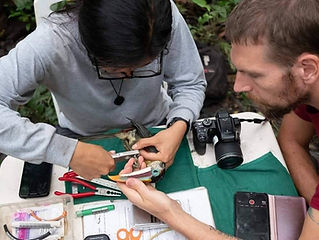
Coordinators Chris and Giria working together to band a Curl-Crested Aracari
Methods Used
The main field methods that the bird team employs under the leadership of our experienced bird research coordinators, include mist-netting in combination with banding or ringing (largely for forest understorey and cryptic species), point count surveys (largely for canopy and flocking species), and camera trap arrays (largely for ground-dwelling species). Each week, between 3-6 days are dedicated to mist nets, 1-3 days to point counts, and 5-7 days to automated camera trap survey techniques. With respect to mist-netting, at each field site we have identified and marked 12-24 sample stations, each separated on average by 200 m, and on each sample day we use 9-12 nets (each 12 m long, 2.5 m high) erected in groups of three. Sampling takes place from dawn for a period of approximately 4 hours, followed by data review (error corrections if required), and potentially dismantling nets and erecting them at the next set of stations. Caught birds are processed quickly, including ringing or banding, recording morphological characteristics, and assessing moult patterns to help age individuals. Birds are released close to the point of capture. When it comes to point count surveys, these are undertaken at 12-24 stations per site during the first 2-4 hours after dawn and for a period of 10 minutes each. Radial distances to birds recorded visually and via auditory cues are estimated and used to calculate species-specific densities using the program Distance. Depending on the field site, some point count stations are located in very open areas (usually river banks) and are used for counting flocking bird species such as parrots, macaws, oropendolas, and caciques as they fly to and from roosting sites. The camera trap arrays consist of 10-20 cameras per site, each separated from each other by at least 200 m. These record terrestrial birds, such as tinamous, ant-pittas, rails, among other species. These camera trap arrays are generally monitored and maintained by the mammal team, however the bird teams assist by checking battery and memory cards and collecting and analyzing records of birds collected by these traps. Again the data is used to assess diversity and relative abundance of species using standard analytical protocols, as well as occupancy modelling to predict species distributions and habitat suitability. Data analysis and visualisation programs that we use include R, SPSS, Distance, Mark, Estimates, Camera Base, and QGIS.
A Typical Day on the Bird Team
Bird research days are generally split into morning and afternoon sampling sessions. The team, which is led by a research coordinator or two, tries to complete two sessions each day (weather permitting) for a total of around 7 hrs of active field time and data input per day. On most morning sessions, the team gets up early (4.30 am) for breakfast, before setting off by foot to the first sample station. Sampling begins around 5:30 am no matter whether the method is mist netting or point counts. On returning to the field station after 3-4 hours of fieldwork, the team will input and review the data collected, including inputting photos of moult limits identified on each bird captured. Lunch is served at 1 pm, after which team members can relax for a couple of hours. At 3:00 pm, the late afternoon session begins, which can consist of either mist net lane cleaning and erecting mist nets, preparing point count stations for future counts, setting up or taking down camera traps, or collecting habitat data in and around sample stations using 0.05-ha Modified Gentry plots. The team is often back at base camp by 5:30 pm. Occasionally (once every two weeks) the team will go out at night (Sometime between 6 pm to 11 pm) to record presence/absence information on owl, potoo and other largely nocturnal bird species. Daily schedules are subject to change at the discretion of the team coordinators and depending on current projects and weather.
Field Course Internship
This option is for those people interested in learning or improving research techniques and related field skills for studying birds in terrestrial landscapes. We offer beginner, intermediate, advanced and master-level course segments in bird banding/ringing, point count sampling, species identification, and datasheet and database management methods. Each course segment is expected to take approximately 2 weeks for interns to complete, however this is not a set expectation as we understand individuals learn certain skills at different speeds. Progression to the next stage of the course will be at the discretion of the team's head research coordinator. Participants who successfully complete the full course (or the three most advanced segments), with an aptitude for bird research techniques will be considered for opportunities to join our Skilled Research Internship program or be considered for an Assistant Research Coordinator position.
1. Introductory Course Segment - Neotropical Bird Research
Duration: ~2 weeks
Description: Participants will learn (i) the basics of how to prepare a mist net lane in the forest and how to open, close and safely store mist nets; (ii) to handle birds in a safe and ethical manner, using two primary grip modes (though not physical extraction of birds from a net); (iii) the theory behind bird banding and mark-recapture studies, including band or ring application techniques; (iv) the theory behind effectively determining age, sex and reproductive status of birds in the hand, including moult strategies and how these differ within and between families; (v) to identify birds visually and from their calls using field guides, cellphone or mobile apps, photographic plates, and online resources; (vi) the theory behind various extraction methods to get birds out of a net (pros and cons); (vii) the details of the morphological measurements that we collect (including the universal codes used) and will actively take specific measurements from a selection of larger bird species held in the hand while closely supervised by the trainer; (viii) the theory behind point count sampling for species density estimation; and (ix) the theory and practise behind the habitat variables that we collect in and around each sample station (i.e. vegetation plots).
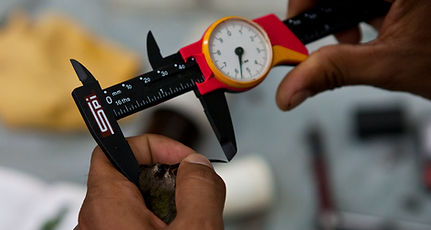.jpg)
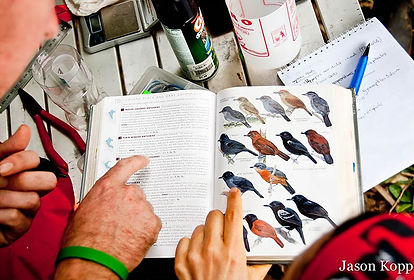
Using the "Birds of Peru" fieldguide to
identify a bird. Photo: Jason Kopp
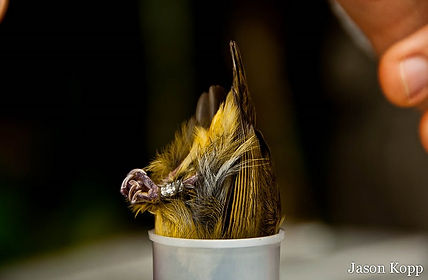
A Band-tailed manakin (Pipra fasciicauda) head down in a cannister, being weighed. Photo: Jason Kopp
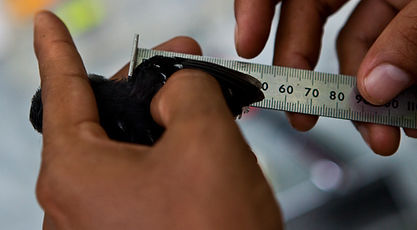.jpg)
An antwren having its wing measured.
Photo: Tom Ambrose
A hummingbird having its beak measured.
Photo: Tom Ambrose
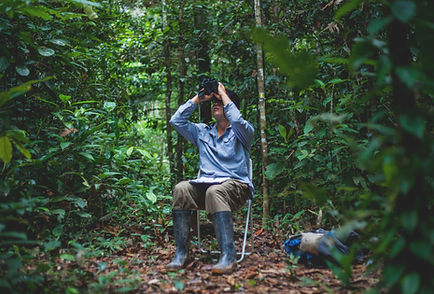%20(6)%20small.jpg)
A point count sample in full swing. Photo: Giovanna Tron.
%20(3)%20small.jpg)
Bagged birds waiting to be processed (measured, weighed, etc.). Photo: Giovanna Tron.

4. Master Course Segment - Neotropical Bird Research
Duration: 2 weeks
Description: Participants will build further competence in all of the key components and skills taught in earlier course segments (see above) but will attain a degree of professionalism in each case that by the end of this 8-week course they should be able to independently undertake all aspects of our bird research protocols with only very little supervision from our bird team coordinators (with supervision focused only on health and safety, bird identification, and data entry and checking. Point counts will always be conducted alongside a research coordinator).
3. Advanced Course Segment - Neotropical Bird Research
Duration: ~2 weeks
Description: Participants will learn (i) to independently establish a new net lane consisting of three 12-m long mist nets in a tropical forest environment, with little supervision; (ii) to safely extract all types of birds (including raptors) from mist nets following one or other of the recommended extraction methods we use, including safely bagging extracted birds for later processing, with only some supervision; (iii) to apply bands or rings to each bird extracted; (iv) to record all categories of morphological data, including moult limits and moult cycle codes used to age birds; (v) to identify birds in the hand using all available guides, apps and other photographic material to an accuracy of 90%; (vi) the theory behind bounded and unbounded detection, and how to analyse this data to estimate bird density; (vii) to identify birds visually at a distance and via their calls with an accuracy of 70% and 50% respectively, especially with regards to sub-canopy and canopy dwelling species; (vii) to accurately estimate radial distances from the centre of a point count station to individual birds or flocks of birds, including techniques for rapid estimation of conspecific flock sizes; (ix) to enter data about each bird into our laptop computers, with only limited supervision, including data review techniques to catch errors and increase quality of the dataset; and (x) the theory and practise behind the habitat variables that we collect in and around each sample station (i.e. vegetation plots), including techniques to analyse this data.
2. Intermediate Course Segment - Neotropical Bird Research
Duration: ~2 weeks
Description: Participants will learn (i) to establish a new net lane consisting of three 12-m long mist nets in a tropical forest environment, with supervision from our bird team coordinators; (ii) to safely extract all types of birds (except raptors and toucans) from mist nets following one or other of the recommended extraction methods we use, including safely bagging the individuals for later processing, with professional over-the-shoulder supervision at all times; (iii) to apply bands or rings to each bird extracted; (iv) to record all categories of morphological data, including moult limits and moult cycle codes used to age birds, with help provided where necessary; (v) to identify birds in the hand using all available guides, apps and other photographic material to an accuracy of 75%; (vi) to independently establish a point count station; (vii) the theory behind bounded and unbounded detection, and how to analyse this data to estimate bird density; (viii) to identify birds visually at a distance and via their calls with an accuracy of 50% and 25% respectively, especially with regards to sub-canopy and canopy dwelling species; (ix) to accurately estimate radial distances from the centre of a point count station to individual birds or small flocks of birds, including techniques for rapid estimation of conspecific flock sizes; (x) to enter data about each bird into our laptop computers, under close supervision, including data review techniques to catch errors and increase quality of the dataset; and (xi) the theory and practise behind the habitat variables that we collect in and around each sample station (i.e. vegetation plots), including techniques to analyse this data.

A Band-tailed manakin about to be released. Photo: Gaby Widerkehr
A thesis student holding a cacique. Photo: Chris Ketola
Thesis Project Internship
If you are a student looking to undertake an official thesis or dissertation project on Neotropical birds in the Peruvian Amazon, and would like to benefit from our expertise and know-how, then this option we offer. You can find out more on the Thesis Project Internship page. We are able to offer support and advice to students regarding project design, implementation and data analysis, along with close supervision from our research coordinators. We have even identified some potential research questions that could be developed into thesis projects, although we are also open to ideas and questions from student applicants. Undergraduate level projects should ideally be planned to be undertaken over a minimum 6-week period. Any shorter and there is no guarantee, in our experience, that sufficient quality data would be collected. Our management team can also provide official supervision and reporting as may be required by colleges and universities. Due to the specific nature of each student's thesis project idea, final costs will be agreed following discussions with the Fauna Forever research team.
Recommended Field Guides and Apps for Volunteers
and Interns on the Bird Team
Field Guides

Birds of Peru
Mobile Applications

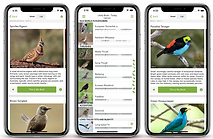
Merlin Bird ID (with Birds of Peru Pack)
Available for both Apple and Android devices
Recommended Academic Articles
Published Articles
Powell (1989) On the possible contribution of mixed-species flocks to species
richness in neotropical avifaunas. Behav Ecol Sociobiot 24: 387-393.
Terborgh (1990) Structure and organization of an Amazonian forest bird
community. Ecological Monographs 60(2): 213-238.
Haselmayer (2000) A comparison of point counts and sound recording as bird
survey methods in Amazonian southeast Peru. The Condor 102: 887-893.
Lloyd (2000) Population densities of the Black-faced Cotinga Conioptilon
cilhennyi in south-east Peru. Bird Conservation International 10: 277-285.
Lloyd (2003) Population densities of some nocturnal raptor species(Strigidae)
in southeastern Peru. Journal of Field Ornithology 74(4):376–380.
Brightsmith (2004) Effects of weather on parrot geophagy in Tambopata, Peru.
Wilson Bulletin 116: 134-145.
Lloyd (2004) Habitat and population estimates of some threatened lowland
forest bird species in Tambopata, south-east Peru. Bird Conservation
International 14: 261–277.
Brightsmith (2005) Competition, predation and nest niche shifts among tropical
cavity nesters: ecological evidence. Journal of Avian Biology 36: 74-83.
Raine (2007) Breeding bird records from the Tambopata-Candamo Reserve
Zone, Madre de Dios, southeast Peru. Cotinga 28: 53-58.
Lieshout et al. (2016) Avian distribution and life-history strategies in Amazonian terra-firme and floodplain forests. Tropical Conservation Science 9(1): 465-502.
Diaz, A. & G. Dimmig (2017) First documented records of Violaceous Quail-Dove (Geotrygon violacea) from Peru. Cotinga 39: 37-40.
Zhou, W., Chalco, M.S., Ketola, C.T. & C. Kirkby (2020) First documented record of Flame-crowned Manakin (Heterocercus linteatus) in Peru, with notes on moult and habitat. Cotinga 42: 101-103.




